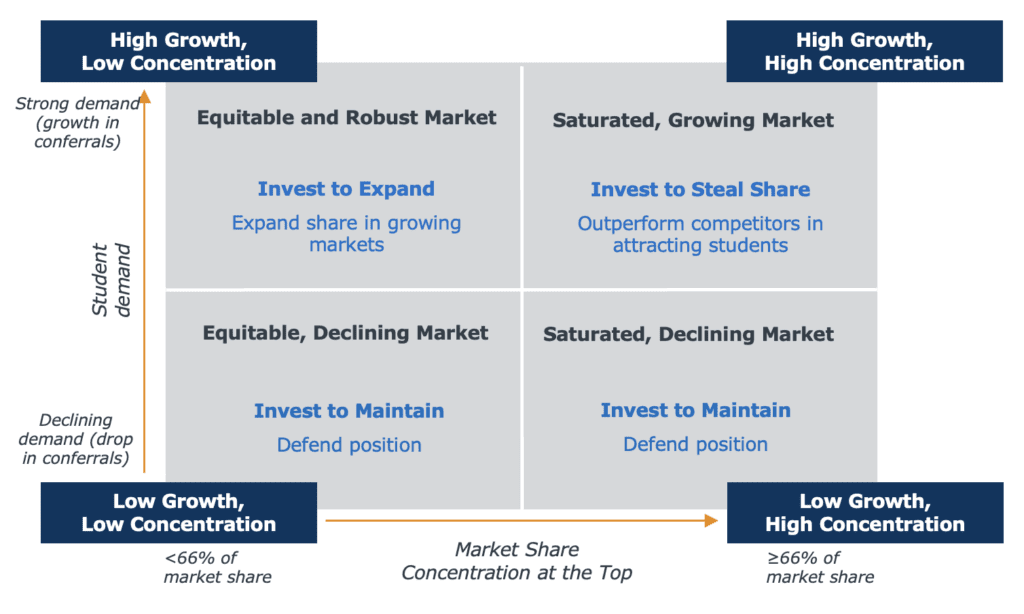How to make the case for investment in graduate enrollment marketing at your campus
In our recent survey of graduate enrollment leaders, 60% of respondents said enrollment goals for their graduate programs increased since last year. But as I saw firsthand as a university CMO, investments in graduate enrollment marketing don’t always increase in tandem with growing goals. Our 2022 survey of university presidents, provosts, and VPEMs confirmed what I saw anecdotally: 65% of surveyed institutions decreased or did not change their budgets to align with growing goals.
If your team is advocating for additional investment in marketing for graduate programs, you’re not alone. Here are four tips to make the case for resources to grow grad marketing and enrollment efforts.
1. Understand—and underscore—the relevance of graduate revenue at your institution
For many institutions, graduate enrollment is an increasingly important part of revenue calculations. In 2021, tuition revenue from graduate and adult-serving programs accounted for 42% of total tuition revenue, up from 40% in 2019. And when we factor in discounts from undergraduate tuition revenue, graduate revenue represents about 50% of total net tuition revenue (NTR).
Consider how this compares to your institution—what percentage of total NTR comes from your graduate and adult education programs? Is grad NTR a growing part of your institution’s total net tuition revenue? The more you can quantify graduate tuition revenue, and its impact on your institution, the better.
2. Share demographic, competitive, and marketing forces that have shifted the enrollment landscape
We’re no longer operating in a “if you build it, they will come” market. Graduate enrollment grew an average of 3.2% from 1990-2021. But from 2021 to 2031, grad enrollment is expected to grow by an average of just 1.1% annually. This is due in part to the demographic cliff, rise of nonconsumption across higher ed, and increased competition from non-university providers. And, as the IPEDS analysis below shows, the supply of graduate programs is outpacing student demand.

At the same time, the costs to market graduate programs, whether through an OPM partnership or via a digital agency, have grown. These vendors rely heavily on channels like paid search. The cost of buying keywords like “online MBA” through paid search is dependent on the basic economics of supply and demand; the more widely in-demand the keywords are, the more expensive they will be. As more programs are created, more competitors enter the paid search market and drive costs up. Paid search is an effective channel, but given its cost and limited reach, should just be one part of a larger, integrated audience generation strategy.
5 ways to make your paid search campaigns more effective
3. Become an expert on the program trends in your region
Regional market factors—specifically student demand and the degree of competition—can help align stakeholders on market opportunities across your graduate portfolio. Become an expert in using publicly available data from IPEDS to understand how your adult-serving programs are faring across two important factors: 1) five-year trends in degree conferrals (to assess student demand) and 2) competitive concentration. Our researchers then use these variables to assess market conditions and recommend an approach to investing aligned with the unique opportunity each program presents given regional conditions.

Beyond degree conferrals and programs offered, our team also looks at employer demand in your primary and secondary markets to identify opportunities to launch new programs or refresh existing programs—perhaps by adding new coursework to meet demand for emerging skills.
See which jobs and skills are in greatest demand in your state
4. Have a voice at the table in budget planning
As graduate enrollment and revenue goals grow, it’s important for key program leaders and stakeholders to have a seat at the table in budget planning and goal-setting conversations. To determine the budget you’ll need to reach your enrollment goals, adopt the following approach:
- Use your enrollment funnel to understand the gap between your existing pipeline of leads and the pipeline your school need to grow enrollments.
- Assign a value to those leads based on your existing cost-per-lead benchmarks
- Advance these conversations with your leadership by proving ROI. Calculate the return on the marketing investment based on the NTR per student and the number of new students you expect your investment to enroll
Here’s how one graduate school generated a 6:1 return on their marketing investments
Today’s enrollment leaders need to go beyond flawless execution to succeed; they need to become experts at leveraging data and insights to align stakeholders on market conditions and investment opportunities across their program portfolio. This is easier said than done. But smart investments in grad growth can have a huge impact on your institution’s present and future.

More Blogs

4 questions domestic students will ask before applying to your graduate program

When Grad PLUS disappears: What 8,000+ grad students said about paying for school
